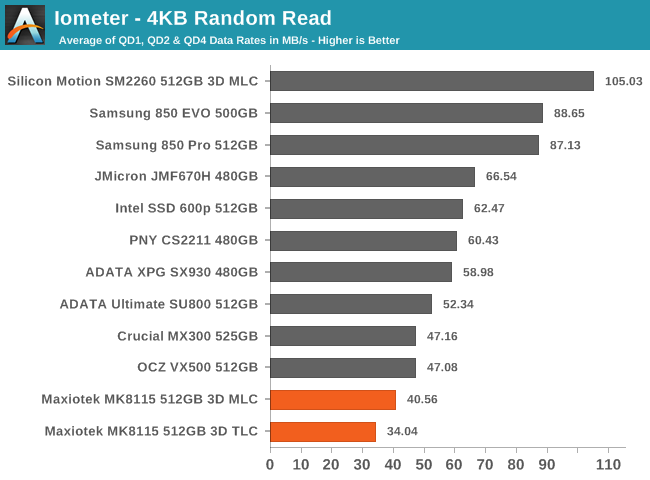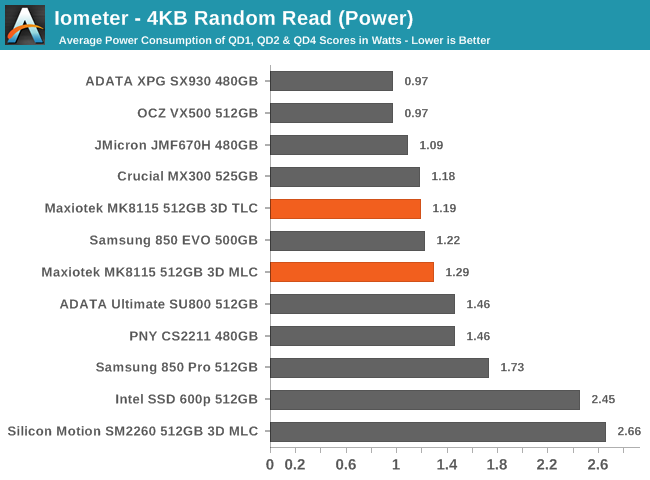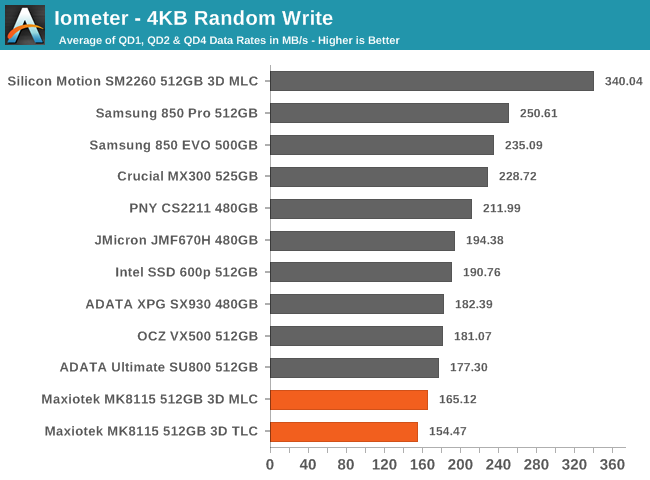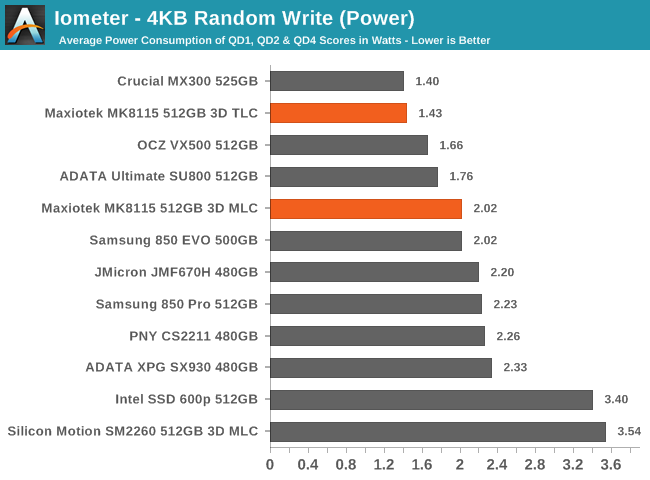Previewing Maxiotek's MK8115 SSD Controller: Can DRAM-less Drives Make The Cut?
by Billy Tallis on May 9, 2017 8:00 AM ESTRandom Read Performance
The random read test requests 4kB blocks and tests queue depths ranging from 1 to 32. The queue depth is doubled every three minutes, for a total test duration of 18 minutes. The test spans the entire drive, which is filled before the test starts. The primary score we report is an average of performances at queue depths 1, 2 and 4, as client usage typically consists mostly of low queue depth operations.

As can be expected, the DRAM-less MK8115 drives come in last in the random read speed test, with the MLC drive 13% slower than the OCZ VX500 and MX300 while the MK8115 TLC drive is closer to 28% slower. Samsung's 850 EVO and PRO are both more than twice as fast as the MK8115 drives.

Power consumption during the random read test is reasonable for both MK8115 drives, but the low performance means neither is particularly efficient.
 |
|||||||||
As queue depths increase both MK8115 samples show moderate increases in performance, tapering off slightly between QD16 and QD32. The MK8115 isn't drawing the most power among SATA SSDs at every single queue depth, but it's close.
Random Write Performance
The random write test writes 4kB blocks and tests queue depths ranging from 1 to 32. The queue depth is doubled every three minutes, for a total test duration of 18 minutes. The test is limited to a 16GB portion of the drive, and the drive is empty save for the 16GB test file. The primary score we report is an average of performances at queue depths 1, 2 and 4, as client usage typically consists mostly of low queue depth operations.

Random write speeds of the MK8115 samples are the slowest out of all the drives in this comparison, but the margin is much smaller than for random reads and nowhere near as large as the disparity in steady-state performance. The difference in performance between the MK8115 samples is smaller than it was for random reads.

The MK8115 drive with MLC levels off after QD8. The TLC counterpart was on track to deliver slightly higher performance at significantly lower power consumption, until the TLC drive filled up and the background garbage collection killed performance and drove up power consumption.
 |
|||||||||
The two MK8115 samples behave rather differently during this random write test. The TLC drive starts out slower at QD1 but performance scales better as queue depth climbs. The TLC drive is also substantially more power efficient, with power consumption growing more slowly than throughput. However, by the end of the test the SLC cache has filled, causing performance to drop below the QD1 throughput and power jumps up to be on par with the MLC drive.










60 Comments
View All Comments
CheapSushi - Wednesday, May 10, 2017 - link
So you sold someone something without researching the hardware in it yourself? Kinda shady but likely he still enjoyed it.rocky12345 - Wednesday, May 10, 2017 - link
Shady? It was a pre built with 3 year warranty the finer detailed spec's were not revealed as in brands like SSD or system memory. He also wanted a gaming system but did not want to pay a lot of money. I would normally build the system myself as a custom so you know what every part is inside and you get to choose the build quality but since he wanted a gaming system on the cheap he got a pre built system. He is happy with it and it actually is a nice system for the money and he got a 3 year warranty from the OEM. So nothing shady going on here...lolwatzupken - Tuesday, May 9, 2017 - link
I am not sure if the price of such DRAM less SSDs is worth buying over a normal budget SSD. In every instance, it is performing very poorly against a budget SSD with DRAM.Lolimaster - Sunday, May 14, 2017 - link
If you're not an OEM than will sells tons of system to uninformed customers, get a good TLC or MLC if possible.jabber - Tuesday, May 9, 2017 - link
Bring back the good old BX100!nervegrind3r - Tuesday, May 9, 2017 - link
inZGamer - Saturday, May 13, 2017 - link
As much as people complain about the low performance....when benchmarking the drive, why compare it against high end consumer SSD's? Compare it against HHD's and SSHDs's where it would actually make sense. This style of drive is not intended to compete against an EVO 850, maybe an MX300 but that would even be pushing it. It will be interesting to see where this is kind of budget SSD ends up on the $/GB scale when it actual reaches production.Lolimaster - Sunday, May 14, 2017 - link
People are actually getting scammed with the prebuild OEM systems with SSD because THAT's when they will include shi*tty dram-less SSD's (in bulk $5-10 off of each system to sell them at the same price is a lot for OEM's).Similar to TLC SSD's, dram-less SSD's consistency goes to sh*t when you empty the SLC cache, if you don't implement it, even worse, you basically get writes slower than a 5400rpm HDD with the system pegging.
I would only touch 850 EVO's, Crucial MX300 for TLC, Kingston HyperX Savage or 850 pro for MLC.
genzai - Tuesday, May 16, 2017 - link
Seems like one good use for Optane would be to replace the DRAM (over a DDR interface) on drives like these.